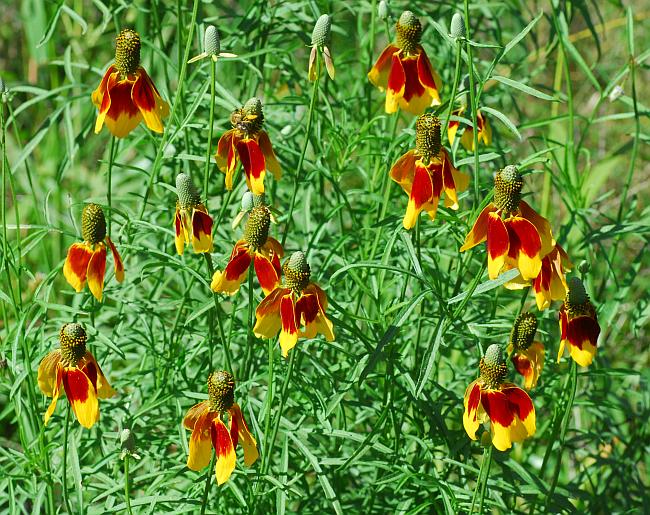Ratibida columnifera (Nutt.) Wooton & Standl.
Longhead Prairie Coneflower

Introduced
CC = *
CW = 5
MOC = 14
© DETenaglia
Ratibida columnifera (Nutt.) Wooton & Standl.Longhead Prairie Coneflower | |
 |
Introduced CC = * CW = 5 MOC = 14 |
© DETenaglia |
|
Family - Asteraceae/Heliantheae Habit - Taprooted perennial forb. Stems - Ascending to erect, to 60 cm, single or multiple from base, simple to branching above, longitudinally ridged, moderately to densely pubescent with antrorse hairs, sometimes nearly glabrous toward the base, also with scattered, minute, sessile, spherical, yellow glands.
Leaves - Alternate, deeply pinnatifid, petiolate below, sessile above. Blades 2-15 cm long, mostly oblong-elliptic to oblong-obovate in outline, 1 or 2 times deeply pinnately divided, the divisions 3-15, 0.1-6.0 cm long, linear to narrowly oblong or oblong-oblanceolate, with 1 inconspicuous vein, the surfaces moderately to densely pubescent with antrorse hairs, usually also gland dotted.
Inflorescence - Single flower head terminating stem and positioned well above leaves. Peduncle to 45 cm , antrorse strigose. Heads - Radiate. Involucral bracts 5-14, in two series of long outer bracts and inner series of minute bracts, those of the outer series 4-15 mm long, linear, antrorse strigose, those of the inner series 1-3 mm long, mostly narrowly ovate. Receptacle columnar, 1-5 cm long. Chaffy bracts subtending and wrapped around the disk florets.
Flowers - Ray florets 4-11, sterile, the corolla 10-35 mm long, yellow or less commonly with a well-defined zone of reddish brown to brownish purple toward the base, this occasionally entirely masking the yellow coloration, notched at the apex, the outer surface moderately to densely but inconspicuously short-hairy, both surfaces usually with scattered, minute, sessile, spherical, yellow glands. Disc florets numerous, perfect, the corolla 1.5-2.5 mm long, 5-lobed, yellow to yellowish green, sometimes purplish-tinged toward the tip. Style branches with the sterile tip short and blunt. Pappus of 1 or 2 minute, triangular, brownish teeth.
Fruits - Achenes 1.5-3.0 mm long, somewhat obliquely oblong, the tip and the angle opposite the chaffy bract with a minute, orangish brown fringe. Flowering - June - September. Habitat - Upland prairies, pastures, railroads, roadsides, open disturbed areas. Also cultivated. Origin - Native to the U.S. Lookalikes - Coreopsis tinctoria. Other info. - This striking plant is found in a few widely spaced counties in Missouri, mostly toward the southwestern portion of the state. It is much more common to our west, throughout the Plains states. The plant is easily recognized when flowering by its peculiarly elongated disk, which serves to distingish this species from others. The ray florets are most commonly yellow (fo. columnifera), though the form with deep red bases (fo. pulcherrima) is certainly strikingly showy and probably the one most often cultivated. Populations deliberately sown along roadsides often fail to persist long term. The disk flowers bloom in an indeterminate fashion along the receptacle. The name columnifera means "column bearing," in recognition of the distinct columnar receptacle. Photographs taken of Hwy 60 near Van Buren, MO., 6-20-04 (DETenaglia); also at the Horse Canyon view area near U.S. Hwy 191, Emery County, UT, 6-20-2015, and near Hope, Eddy County, NM, 5-22-2016 (SRTurner). |